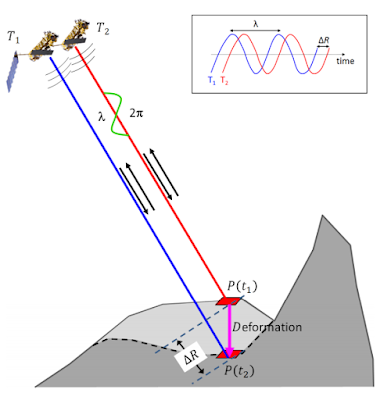Bridge monitoring with satellite data SAR
Civil infrastructure is vital for supporting our life style and economy. However, the prolongued expossure to outdoor weather conditions and time deteriorates the infrastructure. Besides, after some years of decades, the infrastructure do not comply with new construction codes.
This problem of infrastructure deterioration is becoming more important because of the increasing number of infrastructure collapses. Thus, it is important to perform a constant monitoring civil infrastructure.Remote sensing synthetic aperture radar (SAR) data provides a new and modern methodology for monitoring civil infrastructure.
How to monitor infrastructure with satellite data SAR?This problem of infrastructure deterioration is becoming more important because of the increasing number of infrastructure collapses. Thus, it is important to perform a constant monitoring civil infrastructure.Remote sensing synthetic aperture radar (SAR) data provides a new and modern methodology for monitoring civil infrastructure.
The reader may be wondering "How satellite data can used to monitor civil infrastructure such as bridges?". The answer is Interferometric SAR (InSAR) and Differential InSAR.
InSAR takes advantage of the interferometric phase of simultaneous observations. Differential InSAR (SInSAR) considers the interferometric phase of observations acquired at different times. Soussa and Bastos (2013) explain the concept of DInSAR with Figure 1. Two SAR observations at times T1 and T2 will show the deformation DR.
Figure 1. DInSAR concept (Source: Soussa abd Bastos 2013)
Several studies are beginning to take advantage of DInSAR for monitoring bridges. Soussa and Bastos (2013) analyzed ERS SAR observation of the Hintze Ribeiro centennial bridge in Portugal. The bridge collapsed in 2001 when one of its piles collapsed.
The study showed that between 1995 and the collapse date the collapsed pile had vertical displacements up to -20 mm yr-1, where the negative sign means that it was sinking. Other example. In 2012, Cusson et al., (2012) made a similar study at larger scale in Vancouver and Montreal, Canada.
More important than the number of examples however, is the fact that SAR data proved to be an important data source for monitoring civil infrastructure and finding hidden information in collapsed infrastructure.
The study showed that between 1995 and the collapse date the collapsed pile had vertical displacements up to -20 mm yr-1, where the negative sign means that it was sinking. Other example. In 2012, Cusson et al., (2012) made a similar study at larger scale in Vancouver and Montreal, Canada.
More important than the number of examples however, is the fact that SAR data proved to be an important data source for monitoring civil infrastructure and finding hidden information in collapsed infrastructure.
Figure 2. Collapsed Hintze Ribeiro centennial bridge (Cource: StockClip)
Satellite monitoring or in situ monitoring?
Civil infrastructure can also be monitored by in situ inspections. Thus, we may wonder what are the advantages of SAR monitoring?; Is it better to use SAR monitoring or in situ inspection?
There is no definite answer to the last question; it depends on the specific case. Nevertheless, Cusson et al., (2012) points some of the main advantages of SAR monitoring. Among the advantages of SAR monitoring we can mention:
There is no definite answer to the last question; it depends on the specific case. Nevertheless, Cusson et al., (2012) points some of the main advantages of SAR monitoring. Among the advantages of SAR monitoring we can mention:
- Increased and constant monitoring frequency regardless weather or time
- Possibility to monitor the whole structure
- Monitoring regardless accessibility issues.
In further posts we will provide more details and more application cases of SAR data.In you want to know more about DInSAR and SAR application, feel free to contact us.

















No comments
Post a Comment